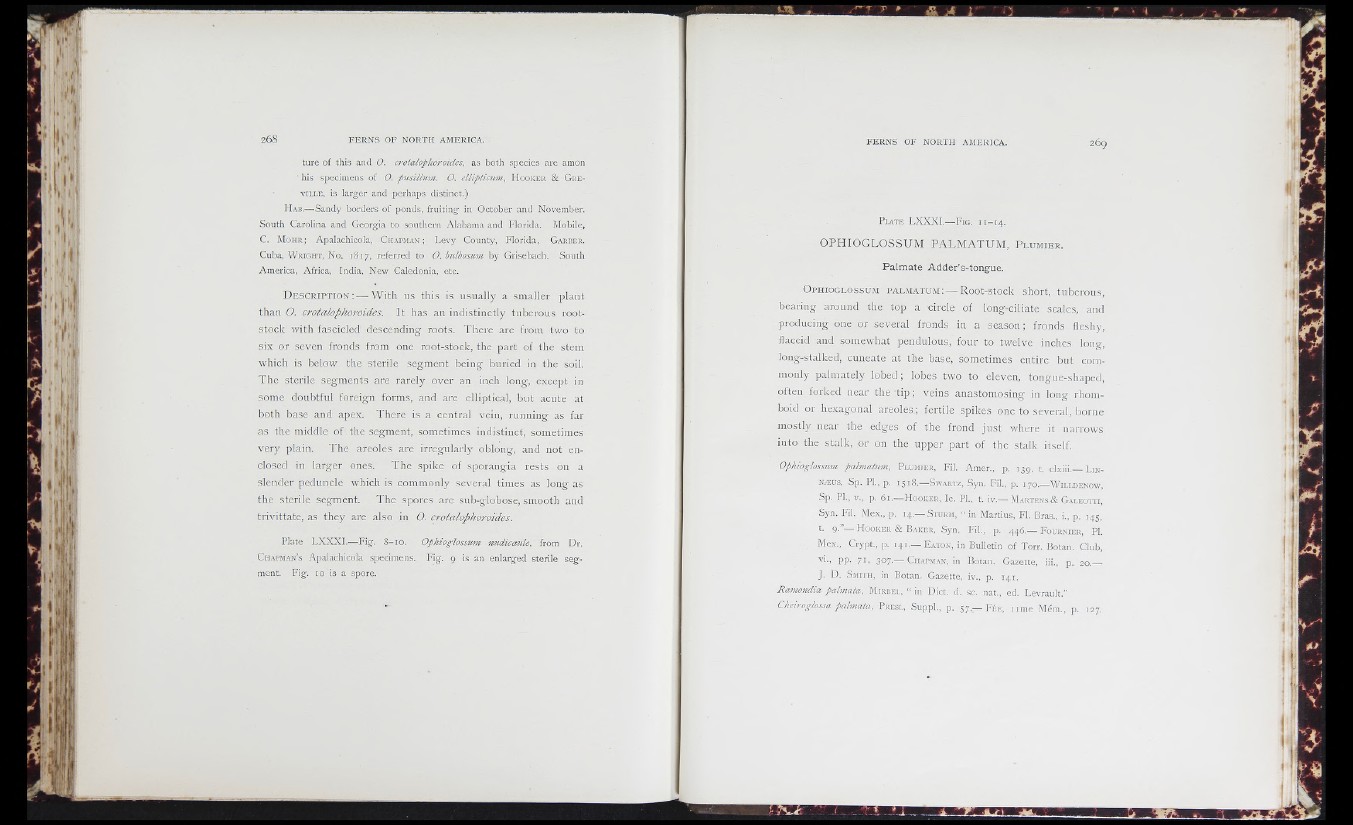
,'it '!!
't ili
Hi
ture o f this and 0 . croialophoroides, a s both .species arc amon
his specimens o f 0. pitsiilum. O. ellipticum. H o o k e r & G r e -
VILLR, is la rge r and perhaps distinct.)
H a s .— Sandy borders of ponds, fruiting in October and November,
South Carolina and Georgia to southern Alabama and P'lorida. Mobile,
C. M o h r ; Apalachicola, C h a pm a n ; Levy County, Florida, G a r b e r .
Cuba, W r ig h t , N o. 18 17 , referred to O. bulbosum by Grisebach. South
America, Africa, India, New Caledonia, etc.
D e s c r i p t i o n : — With us this is usually a smaller jD lan t
than O. crotalophoroides. It has an indistinctly tuberous root-
stock with fascicled descending roots. There are from two to
six or seven fronds from one root-stock, the part of the stem
which is below the sterile segment being buried in the soil.
The sterile segments are rarely over an inch long, except in
some doubtful foreign forms, and are elliptical, but acute at
both base and apex. There is a central vein, running as far
as the middle of the segment, sometimes indistinct, sometimes
very plain. The areoles are irregularly oblong, and not enclosed
in larger ones. The spike of sporangia rests on a
slender peduncle which is commonly several times as long as
the sterile segment. The spores are sub-globose, smooth and
trivittate, as they are also in O. crotalophoroides.
Plate L X X X I.—Fig. 8 -10. Ophioglossum mcdicaule, from Dr.
C h a pm an’s Apalachicola specimens. Fig. 9 is an enlarged sterile segment.
Fig. 10 is a spore.
P l a t e LX X X I .—F ig . 1 1 - 1 4 .
OPHIOGLOSSUM PALM A TUM , P l u m i e r .
Pa lm a te A d d e r ’s-tongue.
O p h io g l o s s u m p a l m a t u m ; — Root-stock short, tuberous,
bearing around the top a circle of long-ciliate scales, and
producing one or several fronds in a season; fronds fleshy,
flaccid and somewhat pendulous, four to twelve inches long,
long-stalked, cuneate at the base, sometimes entire but commonly
palmately lobed; lobes two to eleven, tongue-shaped,
often forked near the tip ; veins anastomosing in long rhomboid
or hexagonal areoles,; fertile spikes one to several, borne
mostly near the edges of the frond just where it narrows
into the stalk, or on the upper part of the stalk itself.
Ophioglossum palmatum, P i.um ie r , F il. A m e r ., p. 1 3 9 , t. c lx iii.— Lm -
NÆUS, S p . P l., p. 1 5 1 8 .— S w a r t z , S y n . F i l , p. 170.— W il i,d e n ow ,
S p . P L , V ., p, 6 1 .— H o o k e r , Ic . PI., t. iv .— M a r t e n s & G a l e o t t i ,
S y n . F il. M e x ., p. 1 4 .— S t u e s i , “ in M a r t in s , F I. B r a s ., i., p. 14 5 ,
t. 9 .”— H o o k e r & B a k e r , S y n . F i l , p. 4 4 6 .— F o u r n i e r , PI.
M e x ., C r y p t ., p. 1 4 1 .— E a t o n , in B u lle t in o f T o r r . B o ta n . C lu b ,
VI-, p p . 7 1 . 3° 7'— C h a p .v an , in B o tan . G a z e t t e , iii., p. 2 0 .—
J . D . Sm ith , in B o t a n . G a z e tte , iv ., p. 1 4 1 .
Ramoitdia pahzata, M irber, “ in D ie t . d. sc . na t., ed . L e v r a u l t ."
Cheiroglossa palmala, P resu, S u p p l , p. 5 7 .— F e e , n i n e M e 'm ., p. 12 7 ,
! l
y *